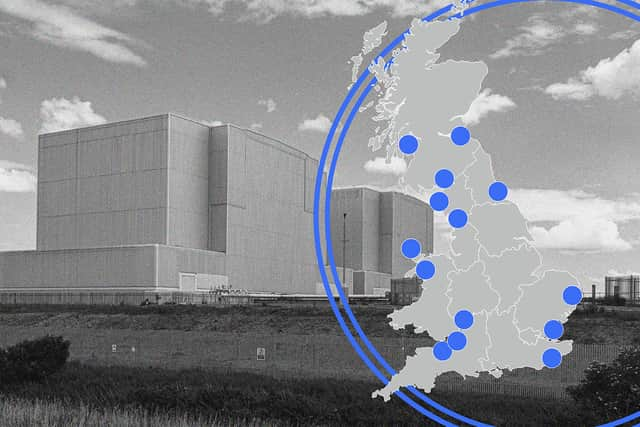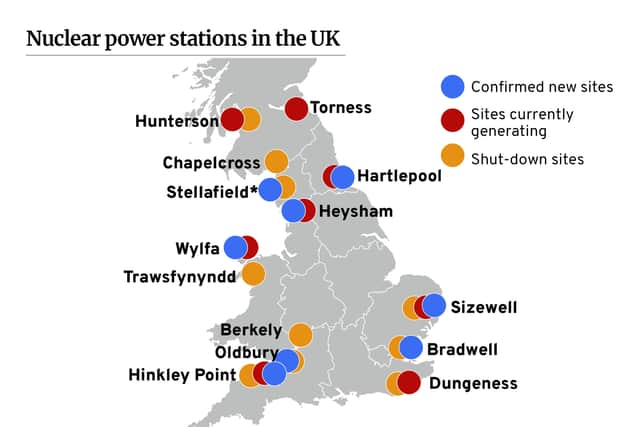Nuclear power stations: how many plants are in the UK, where are new ones being built and are they safe?
and live on Freeview channel 276
The Government has unveiled its new energy strategy which outlines plans to increase the UK’s nuclear capacity.
A new body called Great British Nuclear will be launched to drive the focus on nuclear energy and eight new nuclear power stations will be built - with one being approved each year until 2030.
Advertisement
Hide AdAdvertisement
Hide AdBoris Johnson said there needs to be a “series of big new bets” on nuclear power to make sure the UK’s energy supply is “no longer at the mercy of bullies like Putin”.
However, his plans have been met by reservations from the Treasury about how much it would cost, with warnings issued that billions of pounds will need to be met through bills.
But how many nuclear plants does the UK already have and where are new ones proposed to be built?
How many nuclear plants are in the UK?
There are eight nuclear power stations currently generating in the UK.


- Hunterston, a coastal area in Ayrshire, Scotland
- Torness, east coast of Scotland
- Hartlepool, located in County Durham
- Heysham, located in Lancashire
- Sizewell, located on the Suffolk coast
- Dungeness, on the coast of Kent
- Hinkley Point, located in Somerset
- Wylfa, on the island of Anglesey in Wales
Nuclear power plants are extremely expensive to build.
Advertisement
Hide AdAdvertisement
Hide AdA large-scale plant like the one in Hinkley, named Hinkley C, could cost £23 billion.
The much smaller Small Modular Reactors (SMRs) are estimated to cost about £2 billion - these work in the same way as conventional nuclear reactors but on a smaller scale and generate significantly less power.
Where are new ones being built?
In June 2011, eight sites across Britain were chosen as locations for new nuclear stations.


The eight sites are:
- Bradwell, Essex
- Hartlepool, County Durham
- Heysham, Lancashire
- Hinkley Point, Somerset
- Oldbury, South Gloucestershire
- Sellafield, Cumbria
- Sizewell, Suffolk
- Wylfa, Anglesey
Business Secretary Kwasi Kwarteng recently suggested the UK could have six or seven new nuclear power stations by 2050.
Advertisement
Hide AdAdvertisement
Hide AdThe Government has backed the construction of Hinkley C in Somerset, which will be the largest nuclear station in Britain.
EDF Energy is constructing two EPR nuclear reactors at Hinkley Point in Somerset.
There are also proposals for a nuclear plant on the coastline of Suffolk, known as Sizewell C.
EDF Energy plans to build two further EPR units at Sizewell, in Suffolk.
Advertisement
Hide AdAdvertisement
Hide AdWylfa, a decommissioned nuclear power plant on the island of Anglesey in north Wales, is among half a dozen sites already being considered for new stations.
In February 2021, it was reported that the Welsh government was considering acquiring the Wylfa Newydd site and its staff until a developer for the project was found.
As well as larger nuclear power stations, the Government is also supporting Small Modular Reactors (SMRs).
Are they safe?
Nuclear power plants are subject to strict international safety standards.
Advertisement
Hide AdAdvertisement
Hide AdThe International Atomic Energy Agency, part of the United Nations, says nuclear power plants are among "the safest and most secure facilities in the world".
There was widespread concern in February about the nuclear power station in Ukraine after it was hit by shelling amid the Russian invasion.
There have also been some high-profile accidents, where large amounts of radioactive material were released into the environment, such as the explosion at the Chernobyl nuclear power plant in 1986.
In Japan in 2011 a tsunami caused by an enormous earthquake flooded the Fukushima nuclear plant.
Advertisement
Hide AdAdvertisement
Hide AdUnder normal conditions, generating nuclear power produces hazardous radioactive waste.
This needs to be safely managed and stored for hundreds of years.
However, a House of Lords paper from October 2021 said the issue of nuclear waste remains "unresolved in the UK".
It is currently stored in temporary facilities that are not designed for the permanent storage of "high-level" radioactive waste.
Advertisement
Hide AdAdvertisement
Hide AdThe Government’s preferred solution is "geological disposal" - placing waste deep in a rock formation that would prevent radioactivity from escaping.
However, no community has agreed to host such a facility.
How much nuclear power does the UK use?
In 2020, 16% of the UK’s electricity came from nuclear power plants, according to the UK energy brief 2021 published by the Department for Business, Energy and Industrial Strategy.
However, almost half of the current capacity of nuclear power plants are to be retired by 2025.
The prime minister has previously indicated he would like nuclear power to generate 25% of the UK’s energy by 2050.
Advertisement
Hide AdAdvertisement
Hide AdAlthough a source told the BBC that the Treasury, which is in charge of public spending, had raised concerns about how much this would cost.
Last week The Express also reported that Mr Johnson had yet to convince Chancellor Rishi Sunak to agree on the financial side of the ambitious nuclear project.
Mr Sunak had openly resisted the notion of “rushing to nuclear power”, according to the report.
This comes following Mr Sunak previously denying claims he is blocking the nuclear strategy during a committee hearing on Monday 28 March.
Advertisement
Hide AdAdvertisement
Hide AdThe Chancellor said: “I am certainly not blocking anything, the Prime Minister continues to work through the details of that.
“Given how important it is, I think it is important we get it right... and it is being worked out at pace between all the relevant ministers.”
Comment Guidelines
National World encourages reader discussion on our stories. User feedback, insights and back-and-forth exchanges add a rich layer of context to reporting. Please review our Community Guidelines before commenting.
